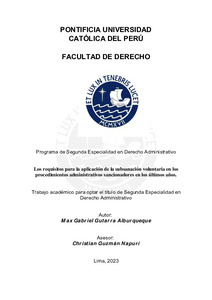Los requisitos para la aplicación de la subsanación voluntaria en los procedimientos administrativos sancionadores en los últimos años.
Abstract
La Subsanación Voluntaria es un eximente de responsabilidad diferente a los
demás que se estipulan en la LPAG, pues no se evidencia una ruptura en el nexo
causal como en los otros. De esta manera, esta diferenciación y el poco
desarrollo que existe en la norma común respecto a esta figura eximente, ha
suscitado un gran debate sobre cuál es la finalidad y lo que se entiende por
Subsanación Voluntaria.
Es así que, esta problemática se extiende hacia los requisitos o elementos
propios de la subsanación, tales como el cese, la reversión y la voluntariedad,
los cuales han sido abordados de forma indistinta por las Entidades Estatales,
entre ellas los organismos reguladores, los cuales tergiversan la aplicación de
estos elementos e imponen mayores requisitos que, muchas veces, tornan
imposible la aplicación de este eximente.
Sobre el particular, se propone que en la norma común se profundice y se
desarrolle los requisitos para la aplicación de la subsanación ya que, de esta
manera, se homogenizará la forma en como se aborda este eximente de
responsabilidad en los PAS correspondientes a las diferentes entidades
Estatales. Asimismo, no podemos quedarnos en la obsoleta concepción de
infracciones que se configuraban por un solo incumplimiento u acción; por el
contrario, se debe abordar específica y diferenciada la aplicación de la
subsanación para conductas que se configuren por varios incumplimientos. The Voluntary Correction is an exoneration of responsibility that is different from
the others stipulated in the LPAG, due to there is no evidence of a break in the
causal link as occur in the others. In this way, this differentiation and the little
development that exists in the common standard regarding this exoneration
figure, has sparked a great debate about what the purpose is and what is
understood by Voluntary Correction.
This is how the last discussion extends to the requirements or elements of
correction such as cessation, reversion and voluntariness, which have been
addressed differentially by state entities. Specifically, it is the regulatory
organizations that distort the application of these elements and impose greater
requirements that, many times, make imposible the application of this
exoneration.
In this regard, it is proposed that the common standard deepen and develop the
requirements for the application of the correction because, in this way, the
approach to this exoneration will be homogenized in the state entities’ PAS.
Likewise, we can not remain with the obsolete conception of infractions that were
formed by an only non-compliance or action. On the contrary, the application of
correction must be addressed in a specific and differentiated way for behaviors
that are constituted by several non-compliances.
Temas
Derecho administrativo
Sanciones administrativas
Procedimiento administrativo
Sanciones administrativas
Procedimiento administrativo
Para optar el título de
Segunda Especialidad en Derecho Administrativo
Collections
The following license files are associated with this item:






